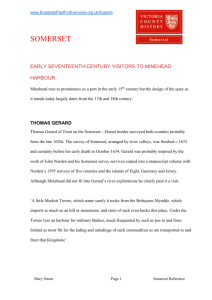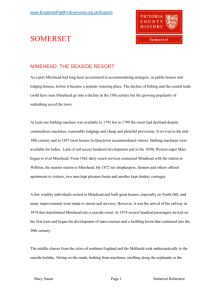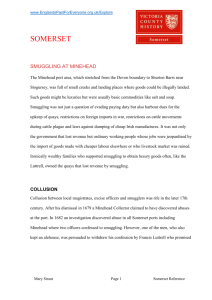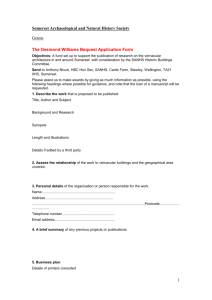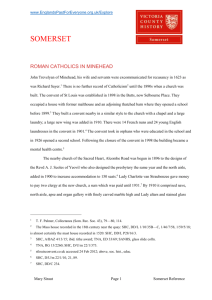file - Victoria County History
advertisement
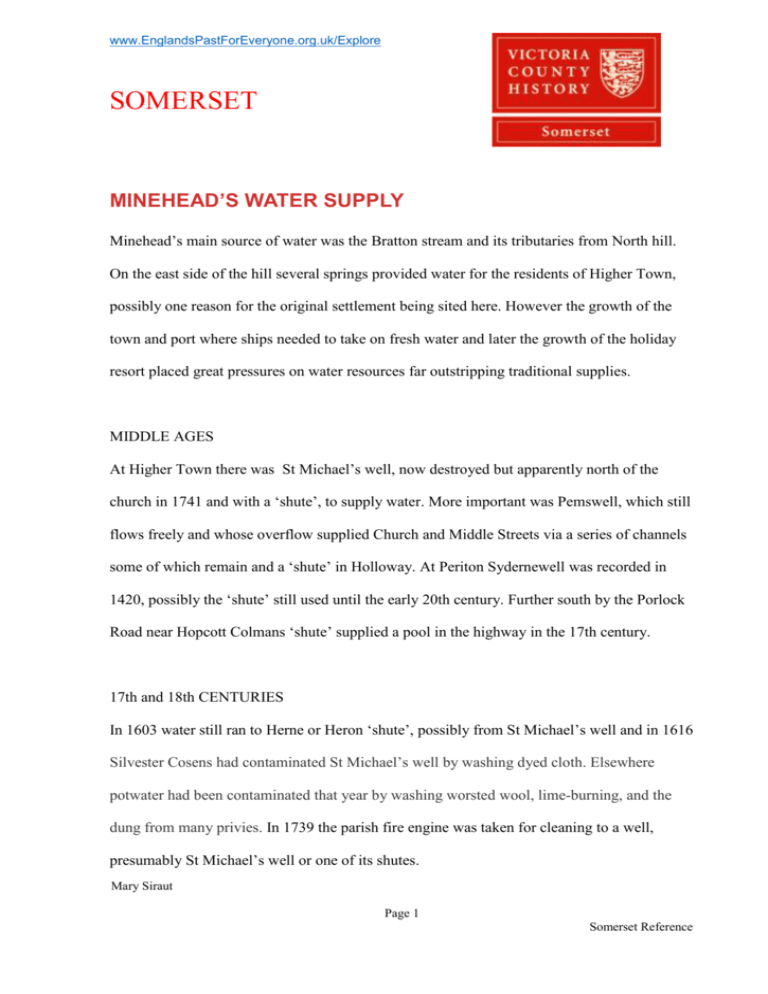
www.EnglandsPastForEveryone.org.uk/Explore SOMERSET MINEHEAD’S WATER SUPPLY Minehead’s main source of water was the Bratton stream and its tributaries from North hill. On the east side of the hill several springs provided water for the residents of Higher Town, possibly one reason for the original settlement being sited here. However the growth of the town and port where ships needed to take on fresh water and later the growth of the holiday resort placed great pressures on water resources far outstripping traditional supplies. MIDDLE AGES At Higher Town there was St Michael’s well, now destroyed but apparently north of the church in 1741 and with a ‘shute’, to supply water. More important was Pemswell, which still flows freely and whose overflow supplied Church and Middle Streets via a series of channels some of which remain and a ‘shute’ in Holloway. At Periton Sydernewell was recorded in 1420, possibly the ‘shute’ still used until the early 20th century. Further south by the Porlock Road near Hopcott Colmans ‘shute’ supplied a pool in the highway in the 17th century. 17th and 18th CENTURIES In 1603 water still ran to Herne or Heron ‘shute’, possibly from St Michael’s well and in 1616 Silvester Cosens had contaminated St Michael’s well by washing dyed cloth. Elsewhere potwater had been contaminated that year by washing worsted wool, lime-burning, and the dung from many privies. In 1739 the parish fire engine was taken for cleaning to a well, presumably St Michael’s well or one of its shutes. Mary Siraut Page 1 Somerset Reference It is not clear if a shute house recorded in 1681 in a garden at Butt’s Lane and let to a Minehead mariner and merchant was for a water supply or not but between 1699 and 1710 the tenants built a herring house beside it costing £150. The Plume of Feathers had a brewhouse in 1768 that was provided with 2 ‘shute’ presumably to supply water. Minehead had a pump maker in the later 17th century, two Friday Street houses had pumps by 1668 and later private and shared pumps were recorded. By the 1780s there was a conduit at the quay an area where fresh water was in short supply but badly needed. It is not clear where the supply came from but attempts had been made over a century earlier to flush the harbour with fresh water. 19th-CENTURY The traditional sources of water remained important and in 1833 people complained that water was diverted from the public water shoot at Holloway in hot weather. This was presumably that shute fed for centuries from Pemswell. Even after the arrival of mains water many people still depended on wells. It was clear that the increase in tourism and the coming of the railway would increase demand for water. The locomotives alone would need a reliable supply. It is therefore no coincidence that the Minehead Waterworks Company was formed in 1874, the year the railway arrived in Minehead. New sources of water were sought inland tapping the many hill streams. Mary Siraut Page 2 Somerset Reference RESERVOIRS AND WATER COMPANIES The Minehead Waterworks Company, formed in 1874, issued 600 shares and completed a reservoir at Turnhill Lea near Lower Moor Farm in 1875 with a capacity of c.85,000 gallons. Water was supplied under a rate, except to the railway which was metered, with extra charges for each water closet, bath or stable; even cottagers using water to flush out their privies were charged extra. Additional supplies from the hills south of the town were piped down Periton Combe and in the 1880s the company imported over 300 tons of iron pipes from Newport. It was too expensive to get water from Dunster and unreliable in dry weather. Supplies remained inadequate and water was turned off at 7 pm. By 1903 the company supplied Minehead, Alcombe and parts of Wootton Courtney and Selworthy. In 1904 the council purchased the water undertakings for over £13,000 and the company was wound up in 1905 when water was still turned off at night. In 1910 G. F. Luttrell leased to Minehead UDC water from an intake works above the existing supply to feed into their reservoir. The total supply of water in 1913 was estimated at 210,000 gallons. A larger reservoir opened near Lower Moor in 1925 but increasing demand continued to put pressure on supplies. Minehead Urban District Council decided to buy Alcombe waterworks in 1928 from the Luttrell estate. The Alcombe Water Works Company was set up in 1884 and immediately Mary Siraut Page 3 Somerset Reference began laying pipes imported from Newport. There were many small watercourses south of Alcombe and around Staunton but they fed the marsh grazing and landowners and farmers worried that abstracting water higher up would lead the land to dry out and be useless for summer grazing. There were also complaints that Minehead UDC’s use of water from the Bratton stream to water the dusty streets in the holiday season would diminish overflow seepage through the ditch into the marshes. Street-watering in dry weather was essential before all streets were tarmacadamed. In 1907 the council considered taking water from the millstream, which fed into the Bratton stream. A reservoir was constructed for Minehead UDC between Alcombe and Staunton Commons c.1930 called Toads Park to supply both Alcombe and Minehead. It was barely completed before it became clear that much more water was needed and a large reservoir was planned at Nutscale in South Pero on Exmoor about 7 miles south-west of Minehead. It was a massive undertaking largely built between 1939 and 1941 but the war delayed completion. However it was eventually finished and had a capacity of 39 million gallons. Water from most sources was piped to the Turnhill Lea reservoir and then distributed but in 1949 concerns were raised about pollution and inadequate filtration. In the 1960s responsibility was transferred to the West Somerset Water Board, from 1974 part of Wessex Water. SEWERAGE Mary Siraut Page 4 Somerset Reference Sewerage Privies were often built over streams or the harbour. Private sewers served the better houses on the Luttrell and Acland estates by the 1890s with an outfall north of the quay, but in 1913 raw sewage was discharged onto land, watercourses and the beach. The local tanyard also drew heavily on local water supplies which became heavily polluted as waste water overflowed in heavy rain and found its way back into watercourses. Sewage contamination from Alcombe affected most of the ditches in the marshes and in 1906 it was agreed to provide a septic tank sewage scheme for the rapidly expanding district. In 1910 Williton RDC maintained the sewage works, which consisted of a septic tank and filter beds, however the creation of a sewage works was said to have exacerbated the problems in the marshes because the sewage beds frequently overflowed. In 1912 it was proposed to discharge sewage into the sea and abandon the tanks. Concern at the impact sewage was having on tourism led to the construction of extended cast iron outfalls in the 1930s to protect the beach and swimmers. Despite the area’s growth and dependence on tourism and awareness of the dangers of water-borne diseases like polio the council showed little interest in dealing with the sewage problem. Only in the 1980s was a sewage treatment works built, near Dunster station, with a pumping station in Mart Road and an outfall at the Warren. Mary Siraut Page 5 Somerset Reference COPYRIGHT All rights, including copyright ©, of the content of this document are owned or controlled by the University of London. For further information refer to http://www.englandspastforeveryone.org.uk/Info/Disclaimer Mary Siraut Page 6 Somerset Reference
